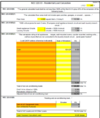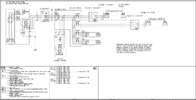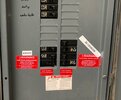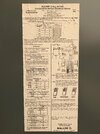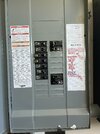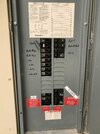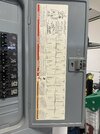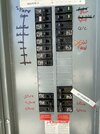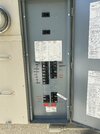Hi All,
Tesla installed 2xPW2 and 1 Gateway, no solar at home on 04/30/2021.
The installation is screwed up in the sense, it is not backing up any of the loads that I consider essential.
Background of my installation:
1) All the loads in the house are split between two panels:
- a main panel (P1) outside the house
- a sub-panel (P2) inside the garage
2) Main panel (P1) has heavy loads and some other lighter loads such as:
- Air conditioners (first and second floor)
- Owen
- Kids bedroom above the garage
- Water heater (just the starter), it is a tankless gas water heater
- A couple of other breakers for lights in the garage
3) Sub panel (P2) in the garage has the breaker for all the other loads in the house
4) The main panel P1 has two service disconnect switches, one for the bus bar in P1 and one for the sub-panel P2
The Tesla guys without consulting me decided that they want to backup the loads on the main panel P1, excluding the ACs.
Those loads they relocated from P1 into another sub-panel that they installed next to the Gateway.
The decided on their own that there is no need to backup the loads on P2, which has all the essential loads in the house.
After two months of back and forth them several different service agents, I was finally able to talk to the original Project Advisor
on my project. She had this to say to me:
"
I heard back from our team with the following:
The issue is the split bus panel and we can only back up one size of the system in this case was the size with the loads mention of lights and the oven. So if we want to back up the other size customer needs to add more PWs to the other subpanel.
It appears we had to choose which size to load based on the what was needed to back up. It appears the only option is to keep the system as is. If you did want to purchase another PW, it would most likely need to be in 2022 as we aren’t offering stand alone Powerwall orders at this time.
"
I spoke to several neighbors, none of them had this problem. I just can't understand how adding an extra PW2 would solve the problem.
All they need to do is to remove the Oven from the backup power center and connect P2 to the gateway.
Please advice how to get this problem resolved. I've not success in getting Tesla to come back address the issues I raised.
Tesla installed 2xPW2 and 1 Gateway, no solar at home on 04/30/2021.
The installation is screwed up in the sense, it is not backing up any of the loads that I consider essential.
Background of my installation:
1) All the loads in the house are split between two panels:
- a main panel (P1) outside the house
- a sub-panel (P2) inside the garage
2) Main panel (P1) has heavy loads and some other lighter loads such as:
- Air conditioners (first and second floor)
- Owen
- Kids bedroom above the garage
- Water heater (just the starter), it is a tankless gas water heater
- A couple of other breakers for lights in the garage
3) Sub panel (P2) in the garage has the breaker for all the other loads in the house
4) The main panel P1 has two service disconnect switches, one for the bus bar in P1 and one for the sub-panel P2
The Tesla guys without consulting me decided that they want to backup the loads on the main panel P1, excluding the ACs.
Those loads they relocated from P1 into another sub-panel that they installed next to the Gateway.
The decided on their own that there is no need to backup the loads on P2, which has all the essential loads in the house.
After two months of back and forth them several different service agents, I was finally able to talk to the original Project Advisor
on my project. She had this to say to me:
"
I heard back from our team with the following:
The issue is the split bus panel and we can only back up one size of the system in this case was the size with the loads mention of lights and the oven. So if we want to back up the other size customer needs to add more PWs to the other subpanel.
It appears we had to choose which size to load based on the what was needed to back up. It appears the only option is to keep the system as is. If you did want to purchase another PW, it would most likely need to be in 2022 as we aren’t offering stand alone Powerwall orders at this time.
"
I spoke to several neighbors, none of them had this problem. I just can't understand how adding an extra PW2 would solve the problem.
All they need to do is to remove the Oven from the backup power center and connect P2 to the gateway.
Please advice how to get this problem resolved. I've not success in getting Tesla to come back address the issues I raised.



